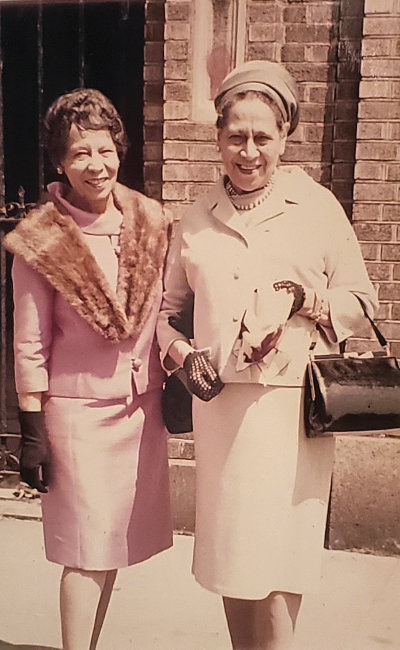Titi Pura: A Conversation with Cristina Maduro and Lisa Fenstermacher
Anika Aldamuy Denise received a 2020 Pura Belpré narrative honor award for the picture-book biography Planting Stories: The Life of Librarian and Storyteller Pura Belpré (art from which, by Paola Escobar, graces this issue’s cover). Anika spoke with Belpré’s great-nieces, sisters Cristina and Lisa, who share their personal recollections of their “Titi Pura.”
Anika Aldamuy Denise received a 2020 Pura Belpré narrative honor award for the picture-book biography Planting Stories: The Life of Librarian and Storyteller Pura Belpré (art from which, by Paola Escobar, graces this issue’s cover). Anika spoke with Belpré’s great-nieces, sisters Cristina and Lisa, who share their personal recollections of their “Titi Pura.”
Anika Aldamuy Denise: I’m honored to talk to you both. First, can you trace for us your relation to Doña Pura Belpré?
Cristina Maduro: Our paternal grandmother, Elisa Maduro, was Pura Belpré’s sister. So we are her great-nieces — though we never really used that term. “Great-nieces” sounds a little formal. She was always just Titi Pura, our aunt.
AAD: Is there an early memory, or one that has especially stayed with you, of experiencing her storytelling talents firsthand?
 Lisa Fenstermacher: What I remember most is her expressiveness and really keying into her voice and how soothing it was. The book I remember her reading the most was Perez and Martina, and her singing the last song: “El Ratoncito Pérez cayó en la olla / Y la cucaracha, Martina — / Lo canta y lo llora…” You’d see a lot of her spirit come out with that song.
Lisa Fenstermacher: What I remember most is her expressiveness and really keying into her voice and how soothing it was. The book I remember her reading the most was Perez and Martina, and her singing the last song: “El Ratoncito Pérez cayó en la olla / Y la cucaracha, Martina — / Lo canta y lo llora…” You’d see a lot of her spirit come out with that song.
CM: Our family is a storytelling family. I remember Titi Pura was a talker.
LF: Yeah, she spoke so much sometimes that I remember our grandmother going, “Ay, Pura!”
CM: We’d get so excited because we would visit my grandparents often and that’s where I’d always see Titi Pura — at her sister’s apartment in the city. Everything was storytelling time. It isn’t necessarily her reading a specific story that I remember most, but that everything was a story.
LF: Titi Pura was someone you experienced. You breathed her in. I remember I always drove everybody crazy asking, “Is Titi Pura coming over? When is she coming over?” And she didn’t come over until she was done with work. Sometimes that would be at 9:30 or 10 o’clock at night, and I would be up waiting for her. She’d come in and it would be raining in New York City and she’d have those weird rubber galoshes —
CM: The ones you put over your shoes?
LF: [laughs] Yes! She would take them off very carefully, and then carefully remove her plastic kerchief. She was so graceful, the way she used her hands. Nothing was ever rushed. And then she’d give you her complete attention.
AAD: Do you have a favorite story of hers?
 CM: I would say The Rainbow-Colored Horse because she dedicated the book to me.
CM: I would say The Rainbow-Colored Horse because she dedicated the book to me.
LF: Perez and Martina. I was looking at my copy, and it was given to me for my second birthday. That tells you how long she was in my life. Titi Pura was there from the start.
 CM: I also remember in elementary school, flipping to the back of my reading textbook and seeing her story Santiago. And excitedly telling my dad, “Titi Pu’s in my reading book!”
CM: I also remember in elementary school, flipping to the back of my reading textbook and seeing her story Santiago. And excitedly telling my dad, “Titi Pu’s in my reading book!”
AAD: Pivoting to more recent years, what has it been like for you and your family, seeing multiple books written about her life, a documentary film, and a prestigious literary award in her name?
LF: It’s not something that we were initially very aware of. I didn’t know that there was an award named after her until I was at a bookstore some years back. I picked out a book that really resonated with me — it was Pam Muñoz Ryan’s Esperanza Rising — and the medallion on the cover said the Pura Belpré Award, and I said, “This is my great-aunt! This is my great-aunt!”

 CM: As a high school and college student, I shared her books and puppets in presentations for Hispanic Heritage Week (which eventually became a month). Years later, while at my daughters’ school during an arts festival, I saw someone reading to children in a circle. It was Lulu Delacre reading The Storyteller’s Candle / La velita de los cuentos, the 2013 picture book about Titi Pura written by Lucía M. González that Lulu illustrated. Discovering that book, and your Planting Stories, has been like a rebirth for me, and for my immediate family, in exploring the historical significance of Titi Pura’s life.
CM: As a high school and college student, I shared her books and puppets in presentations for Hispanic Heritage Week (which eventually became a month). Years later, while at my daughters’ school during an arts festival, I saw someone reading to children in a circle. It was Lulu Delacre reading The Storyteller’s Candle / La velita de los cuentos, the 2013 picture book about Titi Pura written by Lucía M. González that Lulu illustrated. Discovering that book, and your Planting Stories, has been like a rebirth for me, and for my immediate family, in exploring the historical significance of Titi Pura’s life.
AAD: What do you think she’d think of the renaissance of attention on her life and work?
CM: Though I couldn’t begin to know exactly what she’d think, from what I know about her and the women in my family, I believe it would be about the joy in the value that the work has brought, and that it has cultivated in terms of other artists and creators. It’s about the opportunity to continue to share what it always was about: culture, identity, community, and the intersection of those things.
AAD: That joy and intersectionality seems like something you’ve both carried with you into your lives. In what other ways has she influenced you?
LF: I’m a storyteller, but in music. I’m a singer-songwriter, guitar player, and recording artist. I really believe that Titi Pura had a lot to do with me being able to play the guitar. Early on, she gave us a puppet theater, and we had to learn to handle the puppets. They were not easy to work. You had to use your fingers to separate them out, and those are exactly the fine motor skills you need for the guitar. Also, the songs in her stories were how I first experienced my family singing. All these things had an influence on my life and my work.
CM: I’m a style coach. With all the women in the family, including Titi Pura, there was a sense of elegance. Not that they were fancy, but there was always a level of glamour. Titi had her red lipstick and red nails done, always. No matter their socioeconomic level, they were professionals, and there was pride and purpose in who they were and what they wore. They had a strong sense of identity and took up space in a room. That very much aligns with how I coach women in my business.
AAD: Why do think her life story resonates with so many?
LF: Her story is a magical story. You process it in your own way and make it your own. And then ask, How does this apply to my life? One thing my dad always said to me was, “Never forget where you came from.” And I think she really is a beacon that points to where we came from, and also who we can be. For me and my siblings, she educated each of us in the ways that we needed, taking us around the city, to the library, and giving us books. When you’re a kid, you think you’re going to be here forever. As an adult, she knew she wasn’t going to be around forever. And she gave us the stories and experiences she knew we’d need.
AAD: She did that for a whole generation of Latino children in New York and beyond. I am very grateful for that. And to both of you, for sharing your memories of her.
From the May/June 2021 special issue of The Horn Book Magazine: The Pura Belpré Award at 25.

RELATED
ALREADY A SUBSCRIBER? LOG IN
We are currently offering this content for free. Sign up now to activate your personal profile, where you can save articles for future viewing.













Add Comment :-
Be the first reader to comment.
Comment Policy:
Comment should not be empty !!!